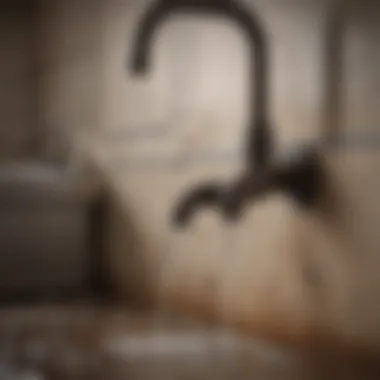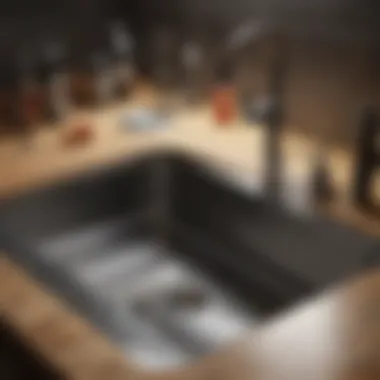Diagnosing and Solving Slow Kitchen Sink Drains


Intro
Slow kitchen sink drains can be a frustrating problem for many homeowners. When water refuses to flow freely, it can lead to various issues beyond mere inconvenience. Digging deeper into the problem reveals that while slow drainage often suggests a blockage, there are instances where no clear obstruction exists. This complexity necessitates an examination of the underlying factors contributing to the reduced drainage efficiency. Understanding these causes is essential, not just for immediate repairs but for long-term plumbing health.
A kitchen sink is more than just a utility fixture. It plays a crucial role in daily kitchen activities, from food preparation to cleaning. When this fixture fails to perform optimally, it disrupts the flow of routine tasks. Consequently, comprehending the reasons behind slow drains becomes not only relevant but imperative for home maintenance.
In this article, we will explore various triggers that may affect the drainage flow. We will discuss diagnostic processes to identify specific problems and provide practical solutions for improving sink efficiency. This comprehensive approach aims to equip homeowners with the knowledge to maintain their plumbing systems effectively.
Ultimately, awareness regarding plumbing health can save money and ensure the kitchen operates smoothly. So, let’s embark on this exploration of slow kitchen sink drains, shedding light on diagnosis and viable remedies.
Preface
Understanding the functionality of kitchen sink drains is crucial for maintaining a healthy home environment. Slow kitchen sink drains can significantly impede everyday tasks. This issue may arise without any visible blockage, leading to confusion about its causes.
Such problems are often exacerbated by the accumulation of everyday waste. Grease, soap residues, and food particles can mix and settle, causing slow drainage over time. Awareness of these factors can become instrumental in avoiding long-term plumbing issues, which may require costly repairs.
Moreover, learning about effective diagnosis methods and solutions can empower homeowners. Simple actions can lead to improved drainage performance, enhancing kitchen usability.
This article discusses various aspects of slow kitchen sink drains. It delves into the diagnosis processes and covers practical remedies. Homeowners will find information that helps them identify and solve these emerging problems in their kitchens.
Ultimately, understanding slow drains is not just about inconvenience; it is about protecting the integrity of the entire plumbing system.
Defining Slow Drainage
Understanding what constitutes slow drainage is essential for any homeowner facing such issues. Slow drainage does not imply an outright blockage in the sink; rather, it indicates that water is moving through the plumbing at a less than optimal speed. Identifying slow drainage accurately can lead to effective remedies and maintenance practices, which can save both time and money.
Slow drainage can be a precursor to more significant plumbing problems if not addressed. Therefore, knowing its characteristics can help in early detection and prevention of backups. This section delves into the defining aspects of slow drainage, highlighting its unique traits and how they differ from standard drainage scenarios.
Characteristics of Slow Drains
A slow drain may present various signs that indicate underlying issues. Some common characteristics include:
- Lingering Water: Water that does not drain completely can accumulate in the sink, sometimes taking several minutes to clear fully.
- Gurgling Noises: Sounds of air escaping through the plumbing system can occur, signaling that there is a disruption in airflow.
- Frequent Slowdowns: A consistent repetition of slow drainage might hint at a recurring problem, often linked to build-up issues.
By observing these signs, homeowners have a starting point for diagnoses and solutions. Addressing slow drainage proactively can prevent both minor inconveniences and larger plumbing concerns later.
Differences Between Slow and Clogged Drains
Understanding the difference between slow drains and completely clogged drains is fundamental for accurate diagnosis. A clogged drain typically does not allow any water to pass through, resulting in standing water. In contrast, a slow drain permits water to flow, albeit at a reduced pace. This distinction is crucial in determining how to address the issue.
To elaborate, here are some contrasting points:
- Flow Rate: A slow drain still allows some water to escape. A clogged drain is like a roadblock; nothing flows.
- Diagnostic Approach: Diagnosing a slow drain involves different techniques such as visual inspections and flow tests, while a clogged drain usually requires immediate intervention like snaking the drain.
- Repair Options: Remedies for slow drains can often involve regular maintenance, while clogged drains may necessitate more aggressive cleaning strategies.
By grasping these differences, homeowners can more strategically approach their plumbing issues, ensuring they implement the right solutions effectively.
Common Causes of Slow Drains


Understanding the common causes of slow kitchen sink drains is crucial for homeowners and property managers alike. Identifying these causes can save time and money in the long run. Slow drainage often signals underlying issues within the plumbing system, which can escalate if not attended to properly. By recognizing the key elements contributing to this problem, effective strategies can be implemented to maintain optimal sink performance.
Accumulation of Grease and Soap
One of the primary culprits behind slow drains is the accumulation of grease and soap. In kitchens, it's common for fats from cooking to be washed down the sink together with soap residues. While these substances might seem harmless when disposed of quickly, they can adhere to pipes over time, creating a sticky buildup that obstructs the water flow.
It's important to realize that even small amounts of grease can cause significant problems when repeatedly introduced into the drainage system. Periodic cleaning and the use of hot water can help dissolve some buildup. However, complete elimination of grease introduction is the best long-term approach.
Foreign Objects in the Trap
Another common issue involves foreign objects trapped in the plumbing trap. Items that accidentally fall into the sink, such as food scraps or utensils, can obstruct drainage. The kitchen trap is designed to catch larger debris; however, small particles can accumulate over time, contributing to slow drainage.
Regular inspections of the trap can help prevent this issue. Clearing out these objects can enhance the flow of water and improve overall drain efficiency. It's a simple check that can save homeowners from more complicated plumbing solutions down the line.
Ventilation Issues
Ventilation plays a critical role in the proper functioning of plumbing systems. If the drains are not adequately vented, negative pressure can create slow draining conditions. Proper venting allows air to flow into plumbing systems, equalizing pressure and enabling effective drainage.
When a vent is blocked or improperly installed, slow drainage can occur. Homeowners should pay attention to any unusual sounds, such as gurgling, which may indicate that venting problems exist. This may require professional plumber assessment to ensure all vents are functioning correctly.
Pipe Configuration and Design Flaws
Lastly, pipe configuration and design flaws can hinder drainage performance. Improperly installed pipes may have sharp turns or be arranged in a way that does not allow for efficient water flow. Pipe diameter and slope can also affect drainage; if pipes are too narrow or level, water may not flow freely.
Homeowners should evaluate their plumbing design as part of diagnosing slow drains. In many cases, consulting with a plumbing expert will provide valuable insights into how the infrastructure can be modified for improved drainage efficiency.
Diagnosis of Slow Drain Issues
Understanding the diagnosis of slow drain issues is crucial for any homeowner or property manager. Slow drains are not just inconveniences; they can signal deeper plumbing problems that, if left unaddressed, may lead to more severe damage. Diagnosing these issues promptly helps maintain both the efficiency of kitchen sinks and the overall health of the plumbing system. Effective diagnosis can save time, prevent costly repairs, and ensure that kitchen and household operations run smoothly.
Visual Inspection Techniques
Visual inspections serve as the first step in diagnosing a slow drain. Homeowners should observe visible components like the sink and its immediate surroundings. Look for signs of water pooling around the sink area or under the cabinet. These could indicate leaks that exacerbate slow drain issues. Additionally, check for discoloration or corrosion on exposed pipes. These visual cues can provide insights into underlying problems, such as mineral buildup or unrecognized leaks. By catching these signs early, one can apply more targeted solutions before the situation worsens.
Utilizing Water Flow Tests
Conducting water flow tests is an effective method to gauge the health of a kitchen sink drain. This involves running water through the sink while observing the rate at which it drains. Homeowners can use a standard stopwatch to time how long it takes for the sink to empty after filling it with a set amount of water. If the drainage time exceeds standard benchmarks for flow, this highlights potential blockages or deeper plumbing issues. Performing these tests can offer a quantifiable assessment of drainage efficiency, guiding further actions or repairs.
Importance of Using a Drain Snake
A drain snake can be a valuable tool in diagnosing and addressing slow kitchen sink drains. This handheld device is designed to navigate the bends of pipes and remove any minor obstructions. When a slow drain is suspected, utilizing a drain snake may help dislodge materials like hair, food particles, or grease buildup that contribute to decreased flow. If the snake encounters resistance, it can indicate a more significant obstruction that requires deeper investigation. Regular use of this tool can also prevent the buildup that leads to slower drainage.
When to Consider Professional Advice
While some slow drain issues can be diagnosed and resolved independently, there are instances where professional intervention becomes necessary. Homeowners should consider calling a plumber when visual inspections reveal severe corrosion or if water flow tests indicate persistent slow drainage despite using a drain snake. Additionally, if multiple drains in the home experience slow drainage simultaneously, this may signify a larger plumbing issue, such as a clogged main sewer line. Recognizing when to seek professional help is essential to prevent minor issues from escalating into significant plumbing emergencies.
Taking proactive measures for diagnosing slow drain issues can significantly enhance the functionality of kitchen sinks and preserve their long-term health.
Understanding these diagnostic techniques will empower homeowners to take informed steps towards resolving slow drain problems effectively.
Preventative Maintenance Strategies
Understanding the importance of preventative maintenance for kitchen sink drains is essential to ensure long-lasting plumbing health and uninterrupted drainage. Taking proactive measures can reduce the likelihood of slow drains and costly repairs. This section explores key strategies to maintain your sink and enhance its performance.
Regular Cleaning Practices


Regular cleaning of kitchen drains can effectively keep them functioning well. Over time, grease, food residue, and soap scum can accumulate, leading to slower drainage. Setting a routine can prevent these buildups.
One effective method is to pour boiling water down the drain once a week. This simple action helps to dissolve grease and flush away any small particles that might obstruct flow. Additionally, using a mixture of baking soda and vinegar creates a chemical reaction that can clean out the drain and eliminate odors.
Using a Drain Strainer
Installing a drain strainer is a fundamental preventative measure. This simple tool captures food scraps and debris before they enter the plumbing system. Regularly cleaning the strainer will keep it free from clogs and allow water to flow smoothly.
Consider various designs available to suit your sink. Some strainers are removable, making cleaning effortless. Keeping the strainer debris-free can significantly reduce the chances of a slow drain.
Monitoring Water Temperature
Monitoring water temperature is often overlooked in drain maintenance. Hot water aids in breaking down leftover grease and soap that can accumulate in pipes. However, it is crucial to avoid pouring extremely hot liquids down the drain regularly, as it may warp plastic pipes and lead to long-term damage.
As a guideline, use hot water for cleaning but balance it with cooler water. This practice helps in maintaining the optimal condition of the plumbing while still promoting efficient drainage.
Proper Disposal Methods for Kitchen Waste
Proper disposal practices for kitchen waste play a vital role in preventing slow drains. A common mistake is disposing of non-biodegradable items, such as coffee grounds, egg shells, and fibrous vegetable scraps via the sink.
Instead, these should be placed in the compost bin or trash. When food waste is disposed of correctly, it significantly reduces the contaminants entering the drain.
Adopting these habits contributes greatly to the longevity and efficiency of your plumbing system. Each strategy emphasizes the need for consistent care and attention for a smooth drainage experience.
Effective Solutions for Slow Drains
Understanding the significance of effective solutions for slow kitchen sink drains is vital for both homeowners and property managers. Slow drains can cause frustration and lead to larger plumbing issues if neglected. Implementing immediate and practical solutions can enhance the flow of water, extend the lifespan of plumbing systems, and even prevent unnecessary repairs. Here, we examine several approaches that can assist in addressing slow drainage issues successfully.
Homemade Remedies
Homemade remedies often represent the first line of defense against slow kitchen sink drains. These solutions are typically affordable and easy to implement. A popular method involves using a mixture of baking soda and vinegar. Pouring half a cup of baking soda down the drain, followed by half a cup of vinegar, can create a chemical reaction. This reaction may help to dislodge minor clogs or buildup within the pipes. It is advisable to let the mixture sit for about 30 minutes, then rinse with hot water.
Another effective solution is boiling water. Pouring boiling water down the drain can dissolve soap scum and grease accumulation within pipes. Repeating this process weekly can maintain proper flow and prevent further slow drainage issues.
Chemical Cleaners: Pros and Cons
Chemical cleaners can be a quick fix for slow drains, but they come with notable advantages and disadvantages. In terms of benefits, these products often work rapidly to dissolve clogs caused by hair, grease, and food particles. They can save time and minimize the need for physical labor. Common chemical drain cleaners include brands like Drano and Liquid-Plumr.
However, there are concerns regarding their safety and environmental impact. Overuse of chemical cleaners can lead to pipe damage and corrosion, particularly in older plumbing systems. Furthermore, many of these cleaners contain harmful substances that can pose risks to both human health and aquatic life. Using chemical cleaners occasionally and in moderation is advisable, ensuring proper ventilation and protective gear during application.
Mechanical Tools for Drain Improvement
Mechanical tools serve as hands-on approaches to improve drain performance. A drain snake, or auger, can be an effective tool for clearing minor clogs and improving flow. This device allows users to reach deep into pipes and break apart obstructions. It is an essential tool for DIY enthusiasts who prefer to avoid chemical solutions.
Another useful tool is a plunger, which can address issues that are not severe enough to require more invasive methods. By creating suction, a plunger can often dislodge blockages without causing damage.
In some cases, professional-grade tools might be necessary. A hydro-jetter uses high-pressure water to clear buildup and stubborn clogs. This option is best left to professionals for optimal results.


Understanding various solutions for slow drains is crucial for long-term plumbing health. Addressing these issues early can prevent further complications.
The Impact of Plumbing Infrastructure
The plumbing infrastructure within a home plays a crucial role in the efficiency of kitchen sink drainage. The materials used and the overall condition of plumbing systems can greatly influence drain performance. Proper knowledge of these factors allows homeowners to make informed decisions regarding maintenance and upgrades.
Pipe Material Considerations
The choice of pipe material is one of the most significant factors affecting drainage efficiency. Common materials used in plumbing include PVC, copper, and cast iron. Each type has its benefits and drawbacks.
- PVC: This is lightweight and resistant to corrosion. Its smooth interior enhances water flow but can become brittle over time.
- Copper: Known for its longevity and resistance to bacteria, copper pipes can be more expensive and are susceptible to damage from extreme temperature changes.
- Cast Iron: While very durable and capable of handling high-pressure, cast iron pipes are prone to rust and corrosion, which can lead to slow drainage if not maintained.
Understanding the material type used in your plumbing can lead to better management practices, prolonging the life of your kitchen sink drainage system.
Age and Condition of Plumbing
The age and overall condition of plumbing systems deserve attention when evaluating slow kitchen sink drains. Older plumbing may be more susceptible to various issues such as blockages, corrosion, or damage.
- Routine assessments of plumbing health can reveal early signs of wear and tear.
- Signs of aging plumbing include noticeable leaks, visible corrosion, or unexpected fluctuations in water pressure.
- Upgrading outdated plumbing can result in improved performance and reduced frequency of slow drainage.
It is essential to recognize that both pipe material and the age of plumbing infrastructure contribute to drainage efficiency. Homeowners must balance these considerations to ensure optimal performance of their kitchen sinks.
Long-term Strategies for Drain Health
Understanding long-term strategies for maintaining drain health is crucial for homeowners. These practices offer significant benefits, ensuring optimal drainage flow while minimizing potential issues. Over time, drains suffer wear and tear, making proactive maintenance essential. This can prevent future slow drainage problems, saving homeowners from costly repairs down the road.
Routine Inspections and Assessments
Routine inspections play a vital role in maintaining the health of kitchen sink drains. Regular checks can help identify minor issues before they escalate. Homeowners should aim to inspect their plumbing systems at least twice a year. During these inspections, one should:
- Check for leaks: Inspect visible pipes under the sink for any signs of leakage.
- Monitor flow rates: Fill the sink and observe if the water drains slowly compared to previous observations.
- Look for odors: Unpleasant smells can indicate a buildup of organic matter or a blockage.
Furthermore, documenting findings over time can reveal patterns, helping identify recurring problems. Homeowners should also take note of any changes in water pressure in their sinks, as this may indicate a larger issue within the plumbing system.
Upgrading Old Plumbing Systems
As plumbing systems age, they may become less efficient, leading to slow drainage. Upgrading old plumbing systems can significantly enhance performance. Modern materials like PVC and PEX are more resistant to clogs and are easier to install than traditional materials such as cast iron or galvanized steel. Benefits of upgrading include:
- Improved flow: New pipes often have a larger diameter and smoother interiors, promoting better water flow.
- Longevity: Modern materials generally have a longer lifespan, reducing the cost and frequency of repairs.
- Increased property value: Upgrading plumbing contributes to overall home improvement, possibly enhancing property value.
The End
The conclusion serves as a pivotal component of this article, wrapping up the information presented and reinforcing the significance of understanding slow kitchen sink drainage. It is essential to acknowledge that a slow drain does not always point to a blockage but can often signify more intricate issues related to plumbing health. By synthesizing the details discussed, homeowners and property owners can gain crucial insights into managing drain efficiency.
First, it is critical to recognize that regular maintenance is key to preventing slow drainage. Practicing consistent cleaning habits and being vigilant about the substances entering the sink can alleviate many issues before they arise. Cleaning practices, such as using a drain strainer and proper waste disposal methods, mitigate the risks associated with grease and foreign objects that often contribute to sluggish drainage.
Second, understanding diagnosis techniques allows homeowners to effectively identify the cause of slow drainage. Being aware of the signs and knowing when to utilize tools like a drain snake can significantly affect the outcome. A visual inspection approach can provide initial clarity, while water flow tests can confirm ongoing issues. In instances where such methods do not yield clear results, professional guidance may be indispensable.
Lastly, considering the plumbing infrastructure and long-term strategies is vital. Evaluating the age and material of pipes may reveal structural weaknesses that need addressing. This can lead to timely upgrades or replacements, ultimately enhancing the overall plumbing system's health.
Understanding slow kitchen sink drains is not merely about addressing symptoms; it involves a comprehensive approach to plumbing care.
By taking the insights provided in this article to heart, readers can develop a better understanding of their home's drainage systems. This proactive approach allows them not only to enhance kitchen sink performance but also to foster a longer-lasting, more efficient plumbing environment. The investment of time and effort into understanding these matters can deliver substantial returns in the form of a functional, trouble-free kitchen sink.















